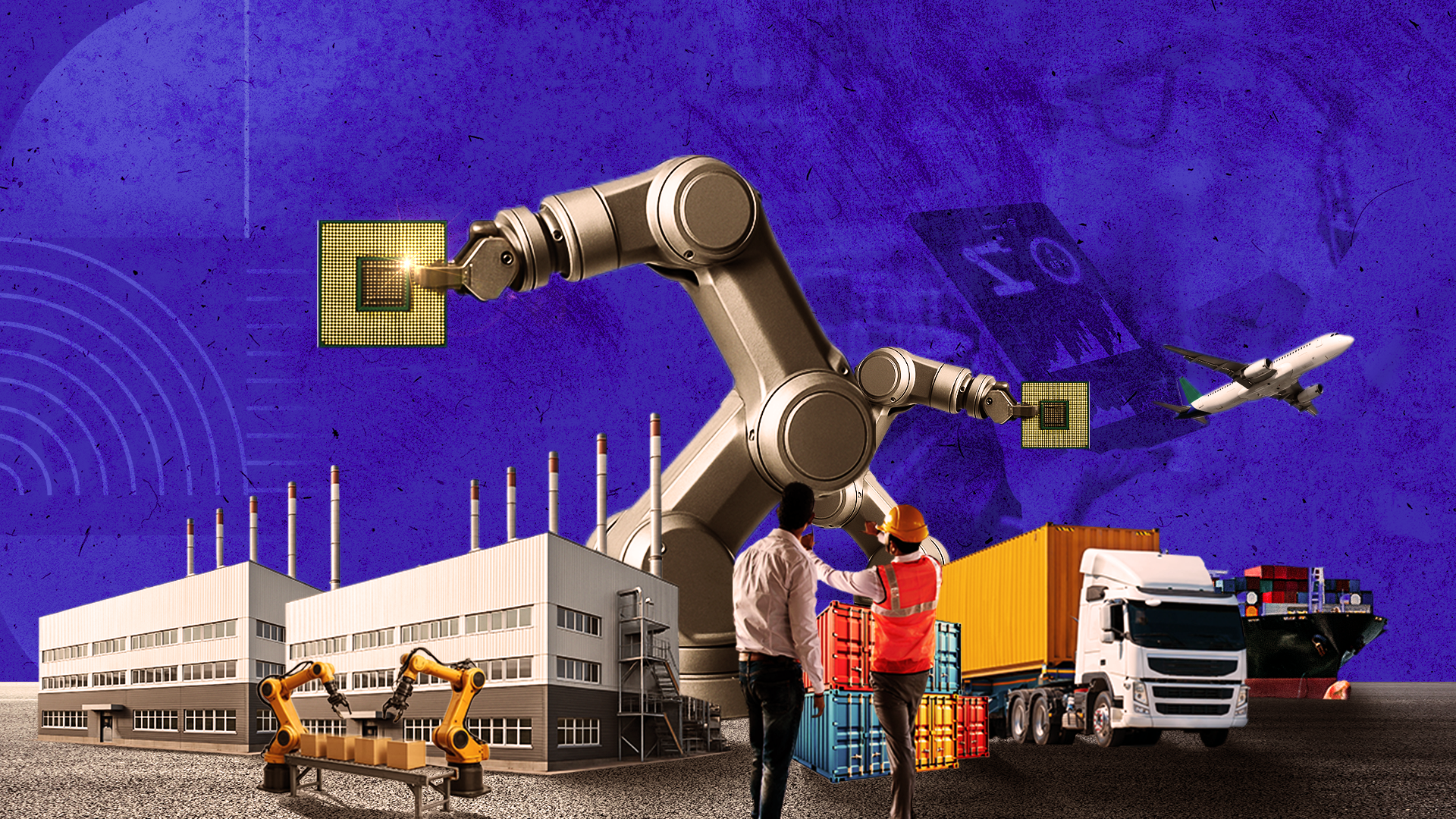Over the past decade, India has reshaped its position in the global trade landscape. Once perceived mainly as a services leader and raw material supplier, the country is now developing into a diverse export power, shipping everything from mobile phones and pharmaceuticals to software, automobiles, and agricultural goods to markets worldwide.
At the heart of this transformation lies the government’s flagship vision: “Make in India for the World.”
When Prime Minister Narendra Modi launched the “Make in India” initiative in 2014, the call was simple yet ambitious: “Come, make in India. Come and manufacture in India. Go and sell in any country in the world but manufacture here.” It was more than just a slogan; it was a strategic blueprint to position India as a reliable manufacturing hub. A decade later, that vision is translating into numbers: India’s exports reached an all-time high of $824.9 Bn in FY2024-25, a 76% increase from 2014-15.1
India’s exports growth momentum reflects not just rising numbers but a structural shift, proving that the nation is not relying solely on its old strengths. It is building new engines of growth that are powering its deeper integration into global supply chains.
India’s export performance
Since the launch of the ‘Make in India for the World’ mission, India’s export story has achieved new milestones. ‘Make in India’ exports reached historic levels in FY 2024-25, with merchandise exports excluding petroleum products valued at $374.1 Bn, an increase of 6% over the previous year, and services exports amounting to $387.5 Bn.2 This balance highlights India’s strength not just in manufacturing but also in knowledge-driven industries.
In FY 2024-25, India’s top export destinations in terms of change in value include, vis-à-vis FY2023-24, the US (11.59%), UK (12.08%), Japan (21.12%), UAE (2.84%), and France (11.42%).3 Together, the top ten countries accounted for over half of India’s merchandise exports, highlighting both diversification and dependence on key partners.
Let’s look at what sectors are driving India’s exports and strengthening Make in India for the World:
Electronics & mobile phones: One of the biggest success stories from the country's Make in India initiative is the electronics goods manufacturing sector, including mobile phones. India became the third-largest mobile phone exporter4, with a staggering 127 times increase from ₹1,500 crore in 2014-15 to ₹2 lakh crore in 2024-255. The mobile production also saw an impressive 28-fold growth, increasing from ₹18,000 crore to ₹5.45 lakh crore in the same period. Electronics manufacturing also grew exponentially, primarily propelled by mobile phones, rising from ₹2.4 lakh crore in 2014 to ₹9.8 lakh crore in 20246. This shift has been mainly driven by the government's Production-Linked Incentive (PLI) scheme, which has attracted global tech giants to establish and expand their manufacturing bases in India, thereby enhancing the country's position as a developing international hub for mobile phone manufacturing.
Pharmaceuticals: Dubbed the 'Pharmacy of the World,'' pharmaceutical exports India rose 102.2% to reach $ 30.47 Bn in FY 2024-25,7 up from $15.07 Bn in FY 2013-14. This growth is supported by India’s position as the world’s largest supplier of generic medicines, accounting for 20% of global volume. The country ranks third in pharmaceutical production by volume and holds a dominant position in vaccines, supplying over 60% of the world’s total output. Additionally, under the Vaccine Maitri initiative, India delivered more than 298 Mn COVID-19 vaccine doses to approximately 100 countries worldwide.8
The NAFTA region remains the largest export market for Indian pharmaceuticals, accounting for nearly 37% of the country’s total pharmaceutical exports. Other leading destinations include Europe, at ~19%, and Africa, at ~13%.9 This export success is further supported by government initiatives such as the PLI scheme, which attracts investments and improves domestic manufacturing capabilities.
Engineering goods: After electronics and pharmaceuticals, India’s engineering goods exports have also experienced a substantial increase, rising from $62.26 Bn in FY201410 to $116.67 Bn in FY2024.11 Covering a broad range of products, from auto components to industrial machinery and transportation equipment, the sector is a key element of the Make in India initiative. Growth is being supported by government measures such as the PLI scheme and FAME India, which encourage the adoption of electric vehicles (EVs) through consumer incentives. Indian automakers are expanding to seize the EV market, with investments of approximately ₹85,420 crore (£10 Bn) in 2025 across electric vehicles, lithium-ion batteries, and EV manufacturing, according to Mood's.12 Although still in its early stages, this trend underscores the rapidly growing contribution of EVs and green-tech components to engineering goods exports India.
Agriculture and food products: India's agricultural and food products, dominated by staples such as rice, spices, seafood, and processed foods, have experienced a substantial increase in exports. It increased from $22.70 Bn in FY201413 to reach $46.44 Bn, constituting roughly 11.7% of India’s total exports.14 The nation ranks as the eighth-largest agricultural exporter worldwide, with its agrarian exports accounting for approximately 2.4% of the global agricultural trade as of 2022.15 India’s export destinations are varied, but the Middle East and ASEAN regions are critical. Key export markets include the US, Bangladesh, China, the UAE, and Saudi Arabia. The Middle East—especially the Gulf Cooperation Council (GCC) countries—relies heavily on food imports, making it a significant market for Indian products, including basmati rice, sugar, spices, and marine products. Similarly, the ASEAN region, comprising nations such as Vietnam and Thailand, is a significant destination for Indian agricultural exports, including seafood and meat.
Textiles, gems & jewellery:
As the second-largest employer in India,16 the textile and apparel sector is among the key contributors to India’s export kitty. The country’s textile and apparel exports rose significantly to ~$36 Bn in FY2024-25.17 Some of the key policies and programs, along with Make in India, supporting this growth include the PLI scheme for textiles, PM Mitra parks and National Textile Mission. Recognised for its diversity, the sector remains a significant source of foreign exchange, alongside the gems and jewellery industry. India, a global leader in the export of cut and polished diamonds, clocked gems and jewellery exports worth $30.47 Bn in FY 2024-25, with the US and UAE acting as key markets.18
Services exports: Beyond merchandise, India’s services exports are a key part of its growth story. Exports in this sector have more than doubled in the past decade, reaching a record high of $387.5 Bn in FY2025.19 While IT and BPM continue to lead, financial, professional, and digital services are gradually broadening India’s global presence.
To further strengthen logistics, reduce heavy reliance on imported raw materials and Active Pharmaceutical Ingredients (APIs), and increase research and development (R&D) as a proportion of GDP, the government has introduced a series of policy measures and incentive schemes aimed at lowering costs, enhancing supply chains, and improving India’s long-term export competitiveness.
Government push: Making India export-ready
The nation’s ‘Made in India’ story is supported by a series of government reforms and incentives ranging from large-scale manufacturing schemes like the PLI to infrastructure upgrades under PM Gati Shakti. These measures collectively create an ecosystem that not only supports exporters but also enhances India’s role in global value chains.
Production Linked Incentive (PLI) Schemes: These schemes cover 14 key sectors and have been a game-changer for India’s export industry. As of March 2025, PLI schemes have attracted actual investments worth ₹1.76 lakh crore, leading to incremental production/sales of over Rs 16.5 lakh crore.20. The scheme has benefitted over 1,300 manufacturing units across 27 states and Union Territories21 and have generated over 12 lakh jobs22.
National Logistics Policy & PM Gati Shakti: Launched in September 2022, the National Logistics Policy aims to reduce India's high logistics costs from the current 13-14% of GDP to a global benchmark of 8% by 2030.23 This policy, along with the PM Gati Shakti National Master Plan, a ₹100 trillion initiative for multi-modal connectivity, aims to enhance infrastructure and streamline operations. Together, they have led to a notable reduction in the average turnaround time for cargo ships at Indian ports and have expedited the planning and implementation of large-scale infrastructure projects.
The Foreign Trade Policy (2023): It has introduced key measures to facilitate exports, marking a dynamic policy without a sunset clause. With a dedicated chapter on e-commerce, India FTP has increased the consignment value limit for e-commerce exports through courier from ₹5 lakh to ₹10 lakh.24 The policy also maintains schemes like the Remission of Duties and Taxes on Exported Products (RoDTEP) and the Rebate of State and Central Levies and Taxes (RoSCTL), which reimburse embedded taxes and duties to enhance export competitiveness.
Ease of Doing Business: To support exporters, the government has simplified the regulatory environment by removing over 42,000 compliance requirements and decriminalising 3,800 provisions.25
These reforms not only lessen the burden on businesses but also bolster investor confidence and facilitate trade, thus laying the foundation for India to expand its global export ambitions.
Conclusion
India’s export journey over the past decade has been nothing short of transformative and stands as a strong testament to the success of the "Make in India for the World" vision. From a country known for traditional exports, India has shifted towards becoming a dynamic, diversified global supplier, driven by a strategic emphasis on manufacturing and technology-led growth. The remarkable rise in sectors such as electronics, pharmaceuticals, and engineering goods clearly demonstrates that the policy framework, including initiatives like the PLI schemes, the National Logistics Policy, and the Foreign Trade Policy, is effectively addressing systemic challenges and prompting a structural transformation.
This growth story, rooted in both goods and services, reflects India's deepening integration into global supply chains and its ambition to become a key pillar of the world economy. By continuing to tackle the remaining challenges, India is well-positioned not only to sustain this momentum but also to establish itself as a leader in global trade.

